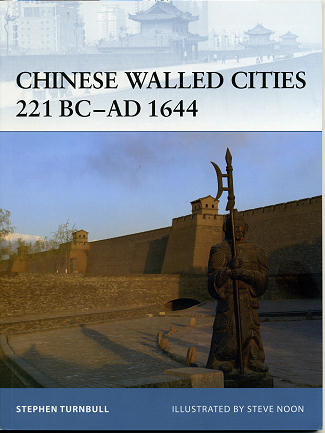 Probably
one of the more prolific city wall builders were the Chinese. With constant
threats from other cities as well as bands of marauders, even the smallest
village had some sort of protective fortification. Of course, the most grandiose
protection built by man is the Great Wall, the only man-made artifact that can
be seen from orbit.
Probably
one of the more prolific city wall builders were the Chinese. With constant
threats from other cities as well as bands of marauders, even the smallest
village had some sort of protective fortification. Of course, the most grandiose
protection built by man is the Great Wall, the only man-made artifact that can
be seen from orbit.
But this book is on city walls and thanks to the Chinese,
many of the more elaborate defensive walls are still extant and many are being
restored to their past splendor. The finest surviving example is at the city of
Pingyao. Most of these structures were made of beaten earth that was covered
with stone or brick to help it hold its shape. Many of these were massive
structures with complex main entry gates, giving the defenders ample opportunity
to stop attackers while still allowing for the normal transit of commerce. Some
were so large as to require over a kilometer of travel into the city before
exiting the gate complex.
Author Stephen Turnbull, an internationally recognized
researcher on the subject and provides a most complete look at Chinese
city wall construction.
The book covers the complete design and implementation of
styles and shows how the various works were modified or improved to meet
the needs of the areas in which they were placed. While all seem to follow a
basic theme, the actual way in which it was carried out was quite dependent on
local geography, as often natural features were incorporated into the defensive
structure. The book looks at the design and development, the principles of
defense, what it was like to live in these walled cities and how they performed
their task in war. There is a more detailed look at the walled structures of
several Chinese cities and how these sites appear today.
All of this is additionally enhanced by photos of the current
sites, period art work and the illustrations of Steve Noon. Though some of the
fortifications are either gone or inaccessible, many are still extant and those
areas are shown and discussed.
In all, a superb addition to the Fortress series and a book
that I believe you will find interesting.
August 2009
For more on the complete line of Osprey books,
visit www.ospreypublishing.com. In the US, it is
Osprey Direct at 44-02 23rd St, Suite 219, Long Island City, NY 11101., where you can
get a catalogue of available books.
If you would like your product reviewed fairly and quickly, please contact
me or see other details in the Note to
Contributors.
 Probably
one of the more prolific city wall builders were the Chinese. With constant
threats from other cities as well as bands of marauders, even the smallest
village had some sort of protective fortification. Of course, the most grandiose
protection built by man is the Great Wall, the only man-made artifact that can
be seen from orbit.
Probably
one of the more prolific city wall builders were the Chinese. With constant
threats from other cities as well as bands of marauders, even the smallest
village had some sort of protective fortification. Of course, the most grandiose
protection built by man is the Great Wall, the only man-made artifact that can
be seen from orbit.